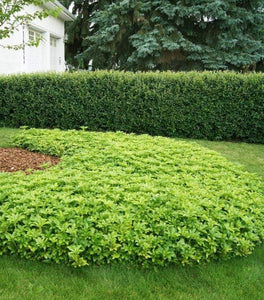Images Depict Mature Plants
Variegated Pachysandra Terminalis for Sale Online
Variegated Pachysandra is a well-loved, highly sought-after plant loved for its charming appearance and hardiness to the elements. Enchanting evergreen foliage is lined with creamy-white scalloped edges and makes for an elegant addition to any landscape.
Ideal conditions for this variegated form of Japanese Spurge include conditions of part-sun to full shade and a well-draining soil medium. The popular ground covers will thrive in an organically rich soil blend. Other than lighting and moisture, the stunning yard plant is maintenance-free and brings unmatched beauty to a space.
Also referenced as Pachysandra Terminalis 'Silver Edge,' Variegated Pachysandra boasts classy oval leaves and creamy white flowers. Popular uses beyond use as ground cover include use in containers, garden edging, as a yard accent, or as a filler in woodland and formal gardens.
| Hardiness Zone: | 4-8 |
|---|---|
| Mature Height: | 6-8 inches |
| Mature Width: | Plant 6 inches on center |
| Sunlight: | Part shade to shade |
| Water Requirements: | Water well until established |
| Selling Points: | Deer Resistant evergreen groundcover |

How to Care for Variegated Pachysandra
Be sure to read our planting instructions to ensure a healthy and happy plant for years to come!
HOW TO WATER VARIEGATED PACHYSANDRA TERMINALIS
Just as with any plant that undergoes a transplantation phase, it needs extra water to support its growth and root system development. Water the groundcover regularly for the first while after it’s been planted in your garden, at least 1-2 times a week (depending on the precipitation and humidity levels in your grow zone).
Once it’s had a chance to establish itself after a few weeks, you can reduce the frequency of watering this groundcover. While it is a drought tolerant plant, the soil should ideally be moist rather than on the drier side. If you can avoid it, we do not recommend letting the soil dry out completely in between watering. However, if this does occur, your Pachysandra Terminalis should not be affected as long as you do not let it stay dry for extended periods of time.
We recommend checking the soil by hand and testing the moisture levels - if it’s damp, let it dry slightly. The ideal texture should be moist, not damp. It’s over watering that kills a plant more often than not. It will take some testing and adjustments to figure out a pattern that works for your schedule.

HOW TO PLANT VARIEGATED PACHYSANDRA TERMINALIS
When you buy a Pachysandra plant online, it’s important to map out the right spot on your property where you plan to plant it. Japanese Pachysandra grows best in organically rich, medium moisture, and well-draining soil. Slightly acidic soil is best (a pH of 5.5. to 6.5 approximately). Due to their low maintenance nature, you can plant this groundcover at any time the soil isn’t frozen; we typically recommend planting it in early spring once the ground has had a chance to soften up and the risk of a hard frost hitting is low.
Once you buy a Pachysandra Terminalis plant, you can expect it to be delivered in bundles. We recommend planting 6-12” apart if the goal is to use it as a groundcover in an area of your property. The root system spreads rapidly by underground stems and will form large colonies.
Dig a trench that’s roughly around 3 inches deep (or as deep as its roots) and around 4 feet long depending on how many you plan to plant. Once you’ve placed the Pachysandra Terminalis into the trench, cover it with soil. It’s important to make sure that the plant is not too deep and sitting below the soil line; it’s best when the plant is level with the ground.
If you have a tree in your yard and want to add dimension or cover the space underneath it where other plants or grass will not grow, you can add up to 3 inches of soil surrounding the tree and plant the Japanese Pachysandra right underneath it. It pairs beautifully with taller trees, creates dimension, and adds a whimsical charm to your landscape.
HOW TO FERTILIZE VARIEGATED PACHYSANDRA TERMINALIS
The ideal time to add fertilizer is in the early spring, giving the plant an added boost of nutrients and support that will help it grow throughout the season. Annual fertilization is sufficient; we recommend using a slow release fertilizer like Bio-Tone Plus Starter Plus. It’s a long standing favorite within the gardening community, and we use it exclusively on our plants. The proven formula promotes growth from beneficial fungi, ectomycorrhizal and endomycorrhizal, that helps the plant absorb nutrients, protects against pests and disease, and much more.
Since the Japanese Pachysandra prefers and grows better in acidic soil, it’s important to maintain that pH level of 5.5-6.5 as mentioned above. If your soil isn’t naturally more acidic, we recommend using the Espoma Soil Acidifier to help you achieve the recommended level. Other acid-loving plants that make great additions to just about any landscape include hydrangeas, azaleas, and rhododendrons to name a few.

SUN EXPOSURE FOR VARIEGATED PACHYSANDRA TERMINALIS
One of the main appeals of the Japanese Pachysandra is that it grows well in darker areas of a garden, therefore, it doesn’t require hardly any direct sunlight. In fact, its foliage tends to bleach when grown in too much sun. You will want to try to find a spot in your yard that provides shade over the groundcover during the high afternoon sun. Morning sun can be beneficial since it’s not as harsh as the afternoon rays.












